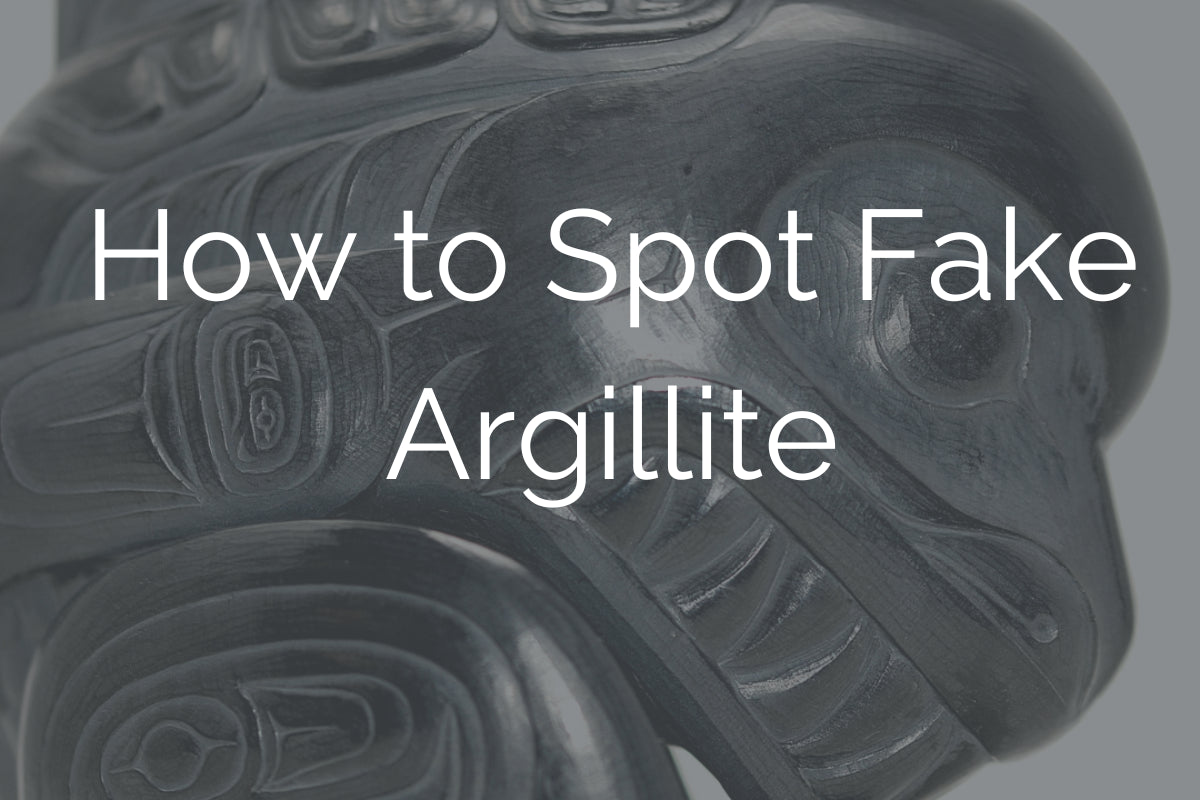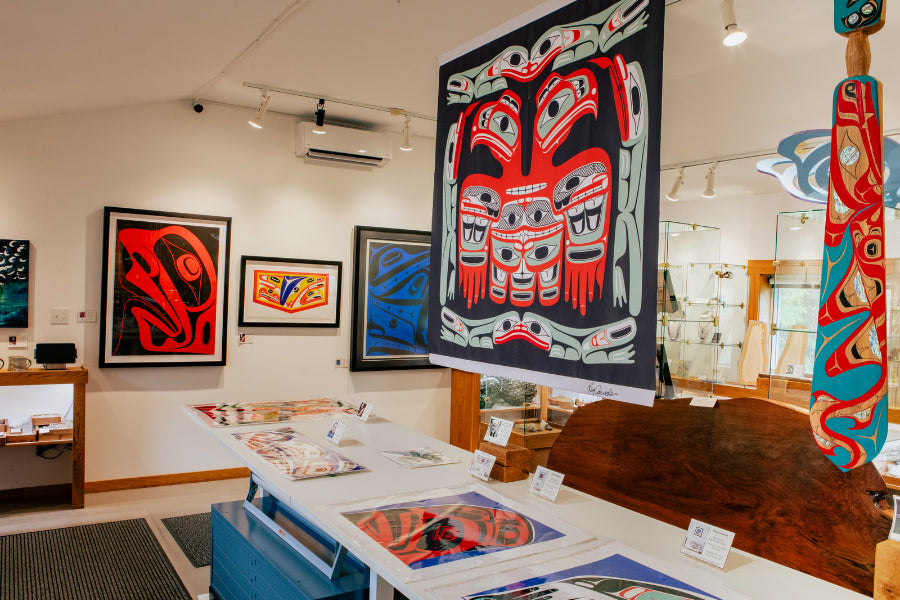Your Cart is Empty
Known as HlGaa K’id in the Haida language Skidegate dialect, argillite is the black gem of Haida Gwaii. Argillite is geologically unique to the Islands and has been carved by Haida carvers since the early 1800s.

Haida Argillite Craver Melanie Russ
The argillite found in Haida Gwaii is specific to these islands and is found within the geological formation known as the Haida Formation. The age of the Haida Formation dates back to the Cretaceous Period, between the Turonian Age (90 million years ago) and the Albian Age (113 million years ago).
Geologically, argillite is considered to be a type of slate, but the argillite of Haida Gwaii first began as shale. As it was exposed to great amounts of heat over time, it transformed and hardened into slate, which we know and recognize today as argillite.
According to geologist Sutherland Brown, who conducted geological research in Haida Gwaii in the 1960s, argillite from the Haida Formation is:
"...composed of silt-sized fragments of kaolinite (a fine clay) present in a fine carbonaceous clay matrix…changes to its structure occurred through folding and heating caused by a nearby volcanic eruption. The resulting modification distinguishes [this argillite] from all other types of argillite and creates the unique properties that enable it to be carved with ease.” (MacNair & Hoover)
Although types of argillite can be found in other parts of North America, the variety of argillite here is unique because it is strong enough to be carved, yet has a softness that allows for intricate detailing. Argillite found elsewhere can be more prone to flaking apart and is not easily carved.
Argillite carvings have an expansive global history too. The Haida began to produce argillite carvings in larger quantities to respond to the demand from European explorers who were in search of exquisite items for trade.
Haida argillite’s unique locale, difficult to access rock quarry, and its protection by the Haida Nation as a stone only to be carved by the Haida people, all contribute to argillite carvings from Haida Gwaii as being a highly sought-after Indigenous art form.
As a locally-owned and operated gallery located on Haida Gwaii, Crystal Cabin Gallery has proudly represented the works of more that 30 Haida artists since 1984. In addition to these artists, we take special pride in highlighting the contributions of two women Haida argillite carvers, Melanie Russ and Amy Edgars. We receive many questions and inquiries about how to determine an authentic argillite carving from a look-a-like, and so we have created this resource to help you know what to look for.

Haida Argillite Carver Amy Edgars
How to Determine if an Argillite Carving is Real:
Touch
How does the stone feel? Is it cool to the touch or plastic-like? Argillite is a stone formed millions of years ago and has the feeling of a genuine stone, which is usually cool to the touch. Alternatively, replicas of argillite carvings, which were produced historically and continue to be produced today, are largely made of resin or plastic and mimic the dark colour of argillite. Resin has a more plastic feel but can be smooth or shiny like argillite. Historically there were resin reproductions of argillite carvings made by a company called Boma, including argillite totem poles. These replicas were made based on actual authentic carvings by Haida artists, such as Charles Edenshaw, and other notable carvers of that time period. For this reason, at first glance it can be easy to mistake a resin replica for an authentic argillite carving.
The weight of argillite is another way to determine real argillite from imitation. The weight may not be evident for smaller pieces of argillite, but there is a noticeable weight attributed to a large 3-dimensional argillite carving. If a large carving feels too light for its size, the piece could possibly be an imitation.
Moh’s Hardness Test
One can use the Mohs Scale to help determine what material a stone is. For example, argillite is an approximate hardness of 2.5 on a scale to 10. In an inconspicuous area, such as the bottom or base of the carving, one could use material of a slightly harder material, to scratch the stone. If the stone can be scratched by this material, this could be an indication that the piece is argillite.
Inconsistencies in the Stone
Argillite is a natural stone and therefore may have inconsistencies, such as small cracks or imperfections in the stone. Resin or plastic, on the other hand, would be smooth and and perfect look with no inconsistencies.
Buy From a Reputable Source
When purchasing argillite carvings today, we recommend that you purchase from a reputable source. This may include an art gallery specializing in Haida art or buying directly from a Haida artist.
Our unique location in Haida Gwaii and close connection to Haida artists and argillite carvers enables us to authenticate the genuineness of the argillite carvings customers purchase inour storeor onour website.

Raven is Super Natural by Haida artist, Melanie Russ
Misconceptions Regarding Authentic Argillite Carvings:
There are a few misconceptions surrounding the originality of argillite carvings, making it confusing to know what’s real and what isn’t. We’ll go over a few of the most common misconceptions we hear about when it comes to determining the originality of argillite carvings.
Presence or Lack of Signature
Today, most argillite carvings are signed by the artist. However, in the old days, it wasn’t uncommon for an argillite carving to go unsigned. The presence or lack of a signature is not indicative of a real or imitation carving. The true signature of an argillite carving is the artwork itself. Someone who is familiar with a particular carver will know its by that artist simply from looking at the carving style.
Less Conventional Argillite Designs & Structures
Different designs and structures of argillite carvings can be observed over time. Today we are used to seeing argillite carvings which depict Haida mythology, transformation stories, or supernatural beings, for example. However, argillite from the past could also include a less traditional design, such as European figures or the ships of European explorers.
Also, the structure of argillite carvings can vary from free-form sculptures, totem poles, boxes, flutes, puppets, bows, and plates. Historically, some of these structure, like argillite plates, started to be carved to fill the demand by European traders who wanted to take back argillite plates that mimicked fine china plates that they had back home.
Presence of Inlays
Similarly to varied designs and structures, various inlays have also been used in argillite carvings from the past and present, such as ivory, animal bone, pipestone, or abalone shell. Contemporary argillite carvers of today are also adding new inlays, such as gold, silver, copper, trade beads, and sea glass.

Mountain Goat Woman by Haida artist, Melanie Russ
Downsizing Your Argillite Collection
Are you looking to downsize your collection of argillite carvings? Here are some ideas to help:
- Contact a local art dealer or antique dealer specializing in historical Haida or Northwest Coast art in your area.
- See if a local museum would be interested in accepting your collection as a donation. This contribution to the community and the arts will ensure that the public and the next generation learn about Haida art, culture, and the history of argillite carvings.
- Let relatives or friends know that you are looking to downsize your collection; you might be surprised to learn that someone in your network would be interested in acquiring a new piece of artwork.
- Consider listing the items online through a listing site specializing in collectables or artwork.
Explore our Collection of Argillite carvings & jewelry , either in-store or online!
Not what your looking for? We offer Custom Argillite Carvings as well! Contact us to get started.
| VIEW HAIDA ARGILLITE |
References:
P. MacNair & A. Hoover, The Magic Leaves: A History of Haida Gwaii Argillite Carving. 2002.







Rodney McCoy
February 11, 2025
I wrote to you over a week ago about carving a wing pendent out of Argillite. I would like it to be around 2.5 inches long, .75 to 1 inch wide at its widest part and about 3/8 inch thick. I have attached a photo of a wing shape my wife likes. The carved wing does not need this detail, but would like some feathers. Please send an artist drawing of the carved wing. So that we can offer suggestions. Rodhttps://i.etsystatic.com/25370748/r/il/07c7db/4287250714/il_794xN.4287250714_1cpf.jpg